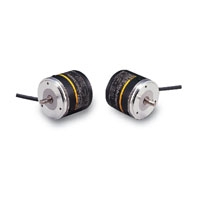Incremental 60-mm-dia. Rotary Encoder
E6F-C
 Rugged Rotary Encoder
Rugged Rotary Encoder
|
Model |
E6F-CWZ5G |
E6F-CWZ5C |
|
|
Power supply voltage |
12 VDC -10% to 24 VDC +15%, ripple (p-p): 5% max. |
||
|
Current consumption *1 |
100 mA max. |
||
|
Resolution |
100, 200, 360, 500, 600, 1,000 |
1,000 |
|
|
Output configuration |
Complementary outputs *2 |
NPN open-collector output |
|
|
Output capacity |
Output voltage: |
Applied voltage: 30 VDC max. |
|
|
Maximum response |
83 kHz |
||
|
Phase difference between |
90°± 45° between A and B (1/4 T ± 1/8 T) |
||
|
Rise and fall times of |
1 μs max. (Cable length: 2 m, Output |
1 μs max. (Cable length: 2 m, Control |
|
|
Starting torque |
10 mNm max. at room temperature, 15 mNm max. at low temperature |
||
|
Moment of inertia |
3 ×10-6 kgm2 max.; 1.5 × 10-6 kgm2 max. at 600 P/R max. |
||
|
Shaft loading |
Radial |
120 N |
|
|
Thrust |
50 N |
||
|
Maximum permissible speed |
5,000 r/min |
||
|
Protection circuits |
Power supply reverse polarity protection, Output load short-circuit protection |
||
|
Ambient temperature range |
Operating: -10 to 70°C (with no icing), Storage: -25 to 85°C (with no icing) |
||
|
Ambient humidity range |
Operating/Storage: 35% to 85% (with no condensation) |
||
|
Insulation resistance |
20 MΩ min. (at 500 VDC) between current-carrying parts and case |
||
|
Dielectric strength |
500 VAC, 50/60 Hz for 1 min between current-carrying parts and case |
||
|
Vibration resistance |
Destruction: 10 to 500 Hz, 150 m/s2 or 2-mm double amplitude for 11 min 3 times each |
||
|
Shock resistance |
Destruction: 1,000 m/s2 3 times each in X, Y, and Z directions |
||
|
Degree of protection |
IEC 60529 IP65, in-house standards: oilproof |
||
|
Connection method |
Pre-wired Models (Standard cable length: 2 m) |
||
|
Material |
Case: Zinc alloy, Main unit: Aluminum, Shaft: SUS420J2 |
||
|
Weight (packed state) |
Approx. 400 g |
||
|
Accessories |
Instruction manual |
||
1. An inrush current of approximately 9 A will flow for approximately 5 μs when the power is turned ON.
2. Complementary Outputs The complementary output has two output transistors (NPN and PNP) as shown at the right. These two output transistors alternately turn ON and OFF depending on the high or low output signal. When using them, pull up to the
positive power supply voltage level or pull down to 0 V. The complementary output allows flow-in or flow-out of the output current and thus the rising and falling speeds of signals are fast. This allows a long cable distance. They can be connected to open-collector input devices (NPN, PNP).





